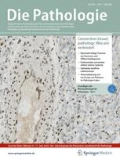Zusammenfassung
Am Beispiel von 4 vollständig paläopathologisch analysierten Grabkomplexen der altägyptischen Nekropole von Theben-West werden das Auftreten und die Häufigkeit bestimmter Erkrankungen an zeitlich definierten Populationen beschrieben ["Mittleres Reich" (MR) und "Neuen Reiches" (NR) bis zur "Spätzeit" (SZ)]. Die Sterbealter- und Geschlechtsverteilung waren ähnlich, das Sterbemaximum lag in der 2.–3. Lebensdekade. Zahlreiche Funde weisen auf eine erhebliche Durchseuchungsrate verschiedener Infektionskrankheiten hin. Mangelerkrankungen betrafen Individuen aus dem MR fast doppelt so häufig wie aus späteren Bevölkerungsgruppen. Die Traumarate lag in beiden Zeiträumen vergleichbar hoch. Degenerative Veränderungen von Wirbelsäule und großen Gelenken kamen in der MR- und der NR-Gruppe erheblich weniger vor als in späteren Zeiträumen. Einzelfälle mit malignen Knochentumoren und weichteilpathologische Befunde deuten daraufhin, dass beim Erreichen eines höheren Lebensalters ähnliche "Zivilisationskrankheiten" wie in heutigen Bevölkerungen auftraten.
Abstract
The scientific investigation of mummies and skeletons provides considerable data for the reconstruction of the living conditions and diseases of past populations. We describe the data on four completely analyzed tomb complexes from the huge necropolis of Thebes-West in Upper Egypt dating to different time periods. A total of 211 individuals from the so-called "Middle Kingdom" (MK, c. 2050–1750 BC) were compared to 273 individuals from the "New Kingdom" (NK) to "Late Period" (LP, in total 1550–500 BC). The age at death and the sex ratio were comparable between both groups. There was a high rate of early death with a maximum between the 2nd and 3rd decade of life but infant/adolescent burials were comparably rare. This early death is assumed to be due to an elevated prevalence of various infectious diseases. Likewise, a high rate of tuberculosis infections was seen in those individuals regardless of which time period they came from. Metabolic disorders with osseous manifestations, such as scurvy, osteomalacia and chronic anemia (cribra orbitalia, porotic hyperostosis) were found with a high frequency in the MK populations but significantly less in the NK-LP populations. On the other hand signs of trauma were comparably high, and lesions due to degenerative joint and vertebral diseases were significantly higher in LP than in MK or NK individuals suggesting a higher mechanical load in the later populations. Cases of malignant (secondary) bone tumors and various soft tissue/organ diseases indicate that "civilization" disorders were present when the living conditions assured survival into advanced age. In summary, we provide circumstantial evidence that the systematic and concise analysis of mummy and skeletal remains can allow a reconstruction of major aspects of life and disease in historic populations, although a complete reconstruction is not possible.
Author information
Authors and Affiliations
Additional information
Electronic Publication
Rights and permissions
About this article
Cite this article
Nerlich, A., Rohrbach, H. & Zink, A. Paläopathologie altägyptischer Mumien und Skelette. Pathologe 23, 379–385 (2002). https://doi.org/10.1007/s00292-002-0558-9
Issue Date:
DOI: https://doi.org/10.1007/s00292-002-0558-9

